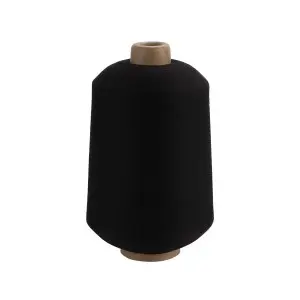Nylon Hot-Melt Yarn Spinning Process
In today’s globalized textile market, nylon hot-melt yarn, as a high-performance specialty fiber, is increasingly attracting the attention of many wholesale buyers. Its unique physical and chemical properties offer enormous potential for application in a wide range of fields, including textiles, apparel, and footwear. This article will delve into the spinning process for nylon hot-melt yarn, detailing each key step from raw material selection to winding and rewinding the final product.
I. Introduction to Nylon Hot-Melt Yarn
Nylon hot-melt yarn is a specialty fiber with a low melting point, thermoplastic properties, and self-adhesive properties. When heated to a certain temperature, it softens and melts into a viscous fluid with a certain degree of fluidity, then solidifies again upon cooling. These properties enable nylon hot-melt yarn, when mixed with other fibers, to form strong and durable fiber products through thermal bonding. These products are widely used in applications such as flyknit shoe uppers, socks and shoes, webbing, wool carpets, and automotive interior linings.
II. Nylon Hot-Melt Yarn Spinning Process
(I) Raw Material Preparation
Nylon hot-melt yarn is typically produced from low-melting-point polyamide. This polyamide is a modified polyester characterized by a low melting point, high thermal bonding strength, and stable physical and chemical properties. In some specialized processes, anti-yellowing nylon hot-melt adhesive masterbatch is added to enhance the fiber’s anti-yellowing properties. The choice of raw materials directly determines the fiber’s basic properties and the ease of subsequent processing.
(II) Polymerization Process
Polymerization is the first and most critical step in the production of nylon hot-melt yarn. During this stage, nylon monomers (usually caprolactam) react with a catalyst under specific temperature conditions to form long-chain nylon polymers. The molecular weight and distribution of the polymers have a decisive influence on the fiber’s properties. For example, a higher molecular weight generally means better fiber strength and wear resistance, but it can also increase spinning difficulty.
(III) Spinning Process
Screw Melting: The polymerized nylon polymer is melted at high temperature and then fed into the screw extruder. During this process, the raw materials are heated and simultaneously compressed and homogenized by the screw extruder to form a uniform melt. The screw temperature and speed must be precisely controlled to ensure melt quality and fluidity. For example, the screw temperature is typically between 200-280°C, and the main engine speed is 200-300 rpm.
Metering and Delivery: The melt is fed through the screw extruder into the composite spinning head and precisely metered by a booster metering pump. The metering pump frequency is typically between 50-100 Hz, ensuring a stable flow of melt into the spinneret.
Compound Spinning: The metered melt is extruded through the composite assembly and spinneret into fine streams. These streams are cooled in the tunnel by side-blown air to form multifilament yarns. The speed, temperature, and humidity of the side-blown air are crucial to the cooling effect and final properties of the fiber. For example, the side-blown air speed is typically 0.1-0.6 m/s, the temperature is 25±2°C, and the humidity is 65±5%.
(IV) Post-Processing
Oil Coating: The cooled multifilament yarn enters the oiling tank for thorough and even oiling. The purpose of oiling is to improve the lubricity of the fibers, reduce friction between fibers, and prevent breakage or entanglement during subsequent processing. Hot Roller Drawing and Setting: The oiled multifilament yarn is drawn through the first and second hot rollers, which are heated to achieve stretching and heat setting. The temperature and speed of the hot rollers need to be adjusted according to the fiber characteristics. For example, the temperature of the first hot roller is 50-100°C and the speed is 3000-3500 m/min; the temperature of the second hot roller is 100-150°C and the speed is 3500-4000 m/min.
Winding and Rewinding: Finally, the heat-set nylon hot melt yarn is wound through a winding device at a speed of 3200-3700 m/min to form the final product. Controlling the winding speed and tension is crucial to ensure fiber winding quality and facilitate subsequent processing.
III. Properties of Nylon Hot Melt Yarn
Nylon hot melt yarn has many excellent properties, including:
Low Melting Point: It melts at relatively low temperatures, making it suitable for various thermal bonding processes.
High Bond Strength: It forms a strong bond with other fibers or materials in its molten state. Excellent physical and chemical stability: Maintains stable performance under a variety of environmental conditions.
Environmentally friendly: The production process produces no harmful substances, meeting modern environmental standards.
Post time: Aug-06-2025

